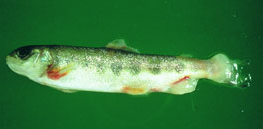Diseases of finfish
Parasitic diseases—Gyrodactylosis
CLICK ON IMAGE TO ENLARGE

Source: T Håstein
Signs of disease
Important: animals with disease may show one or more of the signs below, but disease may still be present in the absence of any signs.
Disease signs at the farm level
- high mortality in Atlantic salmon
Disease signs at the tank and pond level
- scrubbing (rubbing against objects in response to skin irritation) and flashing (darting and twisting of fish and erratic swimming)
Clinical signs of disease in an infected animal
- ulcers on infected fish
- peeling of skin
- fish appear pale
- excess mucus on skin
- frayed fins
Most waters in the region have many types of flukes that are parasitic on fish gills and skin. Any evidence of infestation with these parasites beyond what is visible to the naked eye (as described above) requires confirmation by a trained fish pathologist using microscopy.
Disease agent
The causative agent for gyrodactylosis is Gyrodactylus salaris (a small parasitic flatworm).
Host range
Fish known to be susceptible to gyrodactylosis:
Atlantic salmon* (Salmo salar)
brown trout* (Salmo trutta)
grayling* (Thymallus thymallus)
rainbow trout* (Oncorhynchus mykiss)
Arctic char (Salvelinus alpinus)
brook trout (Salvelinus fontinalis)
lake trout (Salvelinus namaycush)
* naturally susceptible (other species have been shown to be experimentally susceptible)
Presence in Asia–Pacific
EXOTIC — has not been officially reported in the Asia–Pacific region under the NACA–FAO–OIE quarterly aquatic animal disease reporting program.
Epidemiology
- A few parasites cause no problem to healthy populations, but massive infestations lead to compromised resistance to viruses and bacteria.
- Gyrodactylus salaris may be present for years in farmed salmonids, especially rainbow trout, without the fish showing any clinical signs of disease.
- Identification of G. salaris is based on morphology and morphometry of hooks and bars in the opisthaptor (an attachment organ), or by DNA analysis.
- The whole surface of a fish, including gills and mouth cavity, must be examined under a dissecting microscope.
- The parasite can survive a few days at a salinity of 20 ppt, but cannot survive in seawater.
- The parasite can survive 5–6 days unattached to a host, but cannot survive drying out.
- Transmission is horizontal, direct from the water column.
- Parasites can breed prolifically.
- The parasite is readily spread through transport of infested fish.
Differential diagnosis
The differential diagnostic table and the list of similar diseases appearing at the bottom of each disease page refer only to the diseases covered by this field guide. Gross signs observed might well be representative of a wider range of diseases not included here. Therefore, these diagnostic aids should not be read as a guide to a definitive diagnosis, but rather as a tool to help identify the listed diseases that most closely account for the gross signs.
Sample collection
Because of uncertainty in differentiating diseases using only gross signs, and because some aquatic animal disease agents might pose a risk to humans, you should not try to collect samples unless you have been trained. Instead, you should phone your national hotline number and report your observations. If samples have to be collected, the agency taking the call will advise you on what you need to do. Local or district fisheries/veterinary authorities could advise you on sampling.
Emergency disease hotline
For your national emergency disease hotline number, see Whom to contact if you suspect a disease.
Further reading
http://www.oie.int/aac/eng/cards/en_diseasecard.htm
The currently accepted procedures for a conclusive diagnosis of gyrodactylosis are summarised at http://www.oie.int/eng/normes/fmanual/A_00031.htm and http://www.oie.int/eng/normes/fmanual/A_00031.htm
These hyperlinks were correct and functioning at the time of publication.

